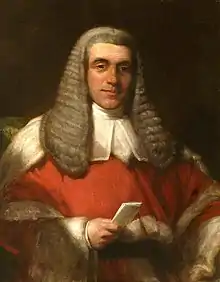John Taylor Coleridge
Sir John Taylor Coleridge (9 July 1790 – 11 February 1876) was an English judge, the second son of Captain James Coleridge and nephew of the poet Samuel Taylor Coleridge.

Life
He was born at Tiverton, Devon, and was educated as a Colleger (King's Scholar) at Eton College, and in 1809 gained a scholarship at Corpus Christi College, Oxford. At Corpus Christi, John Keble became a close friend. Coleridge won the Chancellor's Prize for Latin verse in 1810, graduated first-class in classics in 1812, won the prizes for English and Latin essays in 1813 (as Keble had done in 1811), and became a Vinerian Scholar and a fellow of Exeter College.[1] In 1819 he was called to the bar at the Middle Temple and practised for some years on the western circuit.
In 1824, on William Gifford's retirement, he assumed the editorship of the Quarterly Review, resigning it a year afterwards in favour of John Gibson Lockhart. In 1825 he published a well regarded edition of William Blackstone's Commentaries, and in 1832 he was made a serjeant-at-law and recorder of Exeter. In 1835 he was appointed one of the judges of the King's Bench. In 1852 his university created him a DCL, and in 1858 he resigned his judgeship, and was made a member of the Privy Council, entitling him to sit on the Judicial Committee of the Privy Council. In 1869, he produced his Memoir of the Rev. John Keble,[2] whose friend he had been since their college days, a third edition of which was issued within a year. He died at Ottery St. Mary, Devon, leaving two sons and two daughters.
Coleridge was a member of the Canterbury Association from 24 June 1851.[3]
Leading cases as judge
Family
John married Mary Buchanan at St Peter's, Woodmansterne, Surrey, in 1818; her father, Gilbert Buchanan, was then rector there.[4] John's eldest son, John Duke Coleridge, 1st Baron Coleridge, became Lord Chief Justice of England. The second son, Henry James Coleridge (1822–1893), left the Anglican for the Roman Catholic church in 1852, and became well known as a Jesuit divine, editor of The Month, and author of numerous theological works. Sir John Taylor Coleridge's brothers were James Duke Coleridge and Henry Nelson Coleridge, the latter the husband of Sara Coleridge. His brother Francis George was the father of Arthur Duke Coleridge (born 1830), clerk of assizes on the Midland circuit and author of Eton in the Forties and whose daughter Mary E. Coleridge became a well-known writer of fiction.
Notes
- Hamilton, J. A. (1887). . In Stephen, Leslie (ed.). Dictionary of National Biography. 11. London: Smith, Elder & Co.
- "Review of Memoir of the Rev. John Keble, M.A. by J. T. Coleridge". The Quarterly Review. 127: 98–134. July 1869.
- Blain, Rev. Michael (2007). The Canterbury Association (1848-1852): A Study of Its Members' Connections (PDF). Christchurch: Project Canterbury. pp. 23–24. Retrieved 20 March 2013.
- Busfield D.W. (1981), St Peter's Woodmansterne Registers 1566-1837
References
 This article incorporates text from a publication now in the public domain: Chisholm, Hugh, ed. (1911). "Coleridge, Sir John Taylor". Encyclopædia Britannica. 6 (11th ed.). Cambridge University Press. p. 678.
This article incorporates text from a publication now in the public domain: Chisholm, Hugh, ed. (1911). "Coleridge, Sir John Taylor". Encyclopædia Britannica. 6 (11th ed.). Cambridge University Press. p. 678.
External links
 Works written by or about John Taylor Coleridge at Wikisource
Works written by or about John Taylor Coleridge at Wikisource- "Archival material relating to John Taylor Coleridge". UK National Archives.
